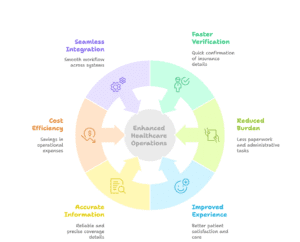On-Demand Outsourcing BPO Services for Healthcare Providers With 24/7 Coverage!
Save up to 70% on staffing costs!
Browse Specialty Staffing ServicesInsurance verification system integration with EHR software

One Friday morning, Dr. Patel, a busy family physician, faced a backlog. With multiple patients awaiting insurance approval for their procedures and no time to manually verify coverage, he was stressed. But then, everything changed. The insurance verification process was streamlined, automated, and integrated directly into his EHR system—without lifting a finger.
The secret? A fully integrated Insurance Verification System with his EHR software.
What Is an Insurance Verification System Integrated with EHR Software?
An insurance verification system integrated with Electronic Health Record (EHR) software allows healthcare providers to automatically verify a patient’s insurance coverage for medical procedures, medications, and surgeries directly from their EHR. This system reduces manual tasks, ensuring quick and accurate verification, all while maintaining HIPAA compliance and secure patient data handling.
Top Reasons Healthcare Practices Are Turning to Integrated Insurance Verification Systems
-
Faster Insurance Verification
By syncing insurance verification with the EHR system, verification is instant, reducing the time spent on phone calls and manual data entry.

-
Reduced Administrative Burden
Automatic insurance checks allow healthcare providers to focus on patient care rather than spending hours on insurance calls and paperwork. -
Improved Patient Experience
With faster approval processes, patients no longer need to wait for confirmation or struggle with insurance confusion, improving overall satisfaction. -
Accurate Coverage Information
Direct integration with insurance providers ensures real-time access to coverage details, minimizing errors that can occur when verifying eligibility manually. -
Cost Efficiency
Reduces administrative costs by eliminating the need for a dedicated insurance verification team, optimizing practice resources. -
Seamless Workflow Integration
By integrating with existing EHR platforms, insurance verification becomes part of the natural workflow, making it easier for healthcare providers to stay on top of their daily tasks.
Real Impact: How Integrated Insurance Verification Is Changing the Game
A surgical clinic in Texas saw a 30% reduction in denied claims after integrating an insurance verification system with their EHR software. An orthopedic practice in New York improved claim approval rates by 25%, saving significant time and reducing the frustration of dealing with insurance paperwork.
In each case, operational efficiency increased, and providers had more time to focus on patient care, not administrative roadblocks.
Staffingly: Your Trusted Partner in Insurance Verification Integration
At Staffingly, we specialize in placing HIPAA-compliant, U.S.-trained professionals to help integrate and manage insurance verification systems within your EHR software. Our experts are experienced in:
-
Real-time insurance verification integration
-
EHR system management and support
-
Automated claim processing
-
Coordination with insurance providers
-
Billing and coding accuracy
What Did We Learn?
Through examining the integration of insurance verification with EHR software, several key insights emerged that highlight the benefits and challenges of this advancement:
-
Efficiency and Speed: Integrating insurance verification directly with EHR systems significantly reduces the time spent on manual verification processes. Instantaneous coverage checks streamline workflows, allowing healthcare providers to focus more on patient care.
-
Improved Accuracy: Automated insurance verification helps eliminate human errors by providing real-time, accurate coverage details. This integration minimizes discrepancies and claim denials, ensuring smoother billing and reimbursement processes.
-
Reduced Administrative Burden: By automating insurance verification, healthcare practices can reduce the strain on administrative staff. This allows staff to focus on other critical tasks like patient care, improving overall efficiency and reducing burnout.
-
Enhanced Patient Experience: Faster insurance approval processes lead to better patient satisfaction. Patients benefit from quicker responses to their coverage inquiries, reducing wait times and confusion around their procedures.
-
Cost Savings: The integration reduces the need for a dedicated insurance verification team, cutting administrative costs. This makes it more affordable for practices, especially smaller ones, to manage insurance verification effectively without sacrificing quality.
-
Seamless Workflow: EHR integration creates a seamless experience for healthcare providers by incorporating insurance verification directly into their everyday systems. This enhances operational efficiency, making the entire verification process part of the normal workflow.
What people are asking?
1. How does insurance verification work with EHR integration?
Insurance verification is automated and occurs in real-time through the EHR system, cross-checking patient coverage directly with insurance providers during appointments or procedures.
2. Are all insurance plans supported by EHR-integrated systems?
Most major insurance plans are compatible, but it’s important to check if specific plans are included in the integrated system’s network.
3. Will this integration reduce insurance claim denials?
Yes, by providing real-time, accurate coverage details, integrated insurance verification reduces errors and helps lower the likelihood of claim denials.
4. Is EHR integration secure and HIPAA-compliant?
Yes, EHR-integrated systems are designed to be secure and HIPAA-compliant, ensuring patient data is protected throughout the verification process.
5. How long does it take to implement this system?
The integration process typically takes a few weeks, depending on the complexity of your existing EHR system and the scope of the integration.
Disclaimer
For tailored support and professional services,
Please contact Staffingly, Inc. at (800) 489-5877
Email : support@staffingly.com.
About This Blog : This Blog is brought to you by Staffingly, Inc., a trusted name in healthcare outsourcing. The team of skilled healthcare specialists and content creators is dedicated to improving the quality and efficiency of healthcare services. The team passionate about sharing knowledge through insightful articles, blogs, and other educational resources. Expanding Healthcare Access Through the Power of Virtual Medical Assistants
 Book a Demo to Build Your Team Today!
Book a Demo to Build Your Team Today!

 Read Case Studies
Read Case Studies 



 Virtual Medical Assistants
Virtual Medical Assistants



